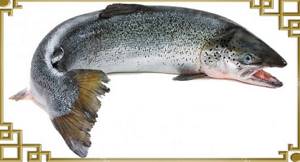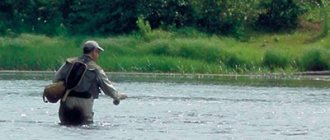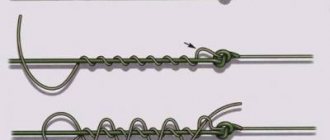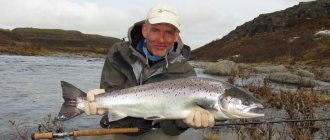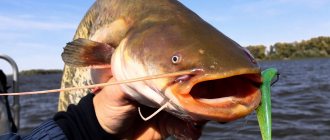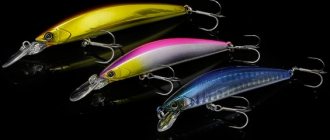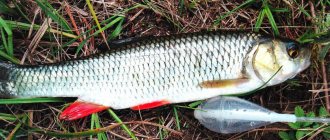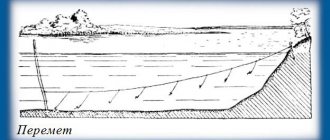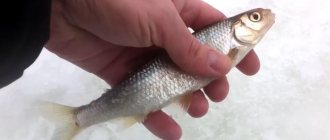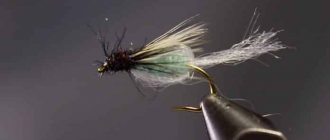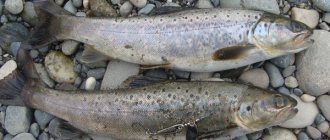Catching salmon is a joy for any fisherman. All over the world, such fishing is considered a rather extreme and dynamic activity. This is due to the difficulty of fighting this type of fish, the strength and power of which is evidenced only by the fact that during spawning, in order to overcome obstacles, salmon is able to jump out of a reservoir 4 m in height.
In this review you will learn where to catch salmon, what gear to use, what baits and lines to use, and at the end of the article you will find a training video on salmon fishing.
Rating of the top 5 spinning rods for salmon and pike
- Daiwa Exceler-AR - (4000 RUR)
- MIKADO NIHONTO MH TELESPIN 240 — (2500 RUR)
- Black Hole Classic 270 — (7500 RUR)
- St. Croix AVID - (6000 RUR)
- Major Craft RIZER - (RUR 13,000)
We will call the St. spinning rod optimal in terms of price/quality ratio. Croix AVID, its main parameters: 2-4 lb., 1/32-3/16 oz., fast action. It is especially suitable for jigging; for twitching it is better to choose shorter spinning rods.
The rod should be designed to handle lures weighing between 10 and 40g and have the strength to handle a 10kg redfish.
Choose a powerful spinning or multiplier reel.
The spinning spool must be at least 3000 in size, since a lot of fishing line must be held, the volume of the spool must be appropriate, with a diameter of 0.30.
Also, the reel must be equipped with a reliable drag to quickly respond to fish jerks. In general, a cheap reel is not suitable for large salmon, as it will break very quickly, choose models from Daiwa, Shimano, Ryoby, from the middle price segment, believe me, a high-quality reel will be more profitable in the long run.
Example of reels: Ryobi Excia MX, Daiwa Revros MX, Daiwa Exist, Shimano Elf, Shimano Twin Power.

You should also grab a few skeins of fishing line or braid. The diameter of monofilament is 0.28-0.35 mm, braided line is 0.12-0.22 mm.
But braided fishing line should only be used in combination with a flexible fishing rod, which will reduce the possibility of slips. It is preferable to use monofilament, although the performance of wobblers will be better on braid.
Salmon is an extremely strong fish. It is worth taking care of a sufficient supply of fishing line, because this fish is capable of making throws of 50-70 m.
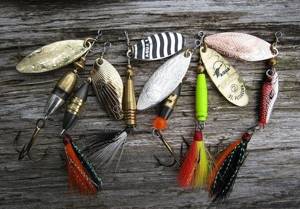
Therefore, the optimal length of line on a reel is approximately 150 m.
Before you start fishing, you should once again check all fasteners and carabiners, rings and tees.
Where do they catch salmon?
Salmon belong to the category of migratory fish that live in the sea or lakes, and rise into rivers only for the purpose of reproduction.
In most cases, after reaching 4-6 years of age, all salmon species enter very fast rivers with rapids and often rise upstream for several hundred kilometers.
The periods of entry of salmon into rivers are not the same: salmon of the so-called “spring” form enter in the summer and early autumn before spawning, while adherents of the “winter” form enter either in late autumn or early spring, and stay there until spawning on average for about a year .
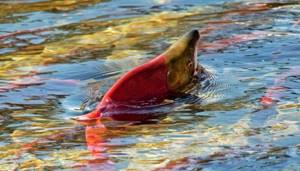
As a stopover in rivers during the period before spawning, salmon choose small, fast places in reservoirs with a rocky or sandy-pebble bottom surface.
When to catch salmon
Experience shows that the best natural conditions for trolling salmon are cloudy weather and the presence of a small wave.
Fishing will be especially productive in early spring or at the beginning of the summer season. At this time, specimens of different weights come across - from 4 to 20 kg. From the second half of June until the beginning of November, salmon are caught in rivers more often than in lakes.
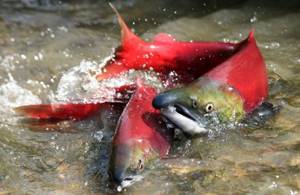
Salmon spawn mainly at water temperatures of no more than 6-7 degrees. These are, first of all, indicators for the period from the second half of September to mid-November.
For spawning, salmon prefer running waters, and for feeding purposes, they choose areas of calm water where there is enough food.
Young individuals feed mainly on various insects and small aquatic invertebrates, while adult salmon also do not refuse crustaceans and small fish.
Trout and salmon rods. The agony of choice and testing at the Greenvald paid reservoir.
About 20 years ago, many Russian spinning anglers’ acquaintance with decent tackle began with the so-called “steelheads” of American origin. What did they do with them! They were jigging and throwing small wobblers. But something similar to the original purpose (such as fishing with a spoon in the current) was done with them extremely rarely. It was then that we became acquainted with spinning rods from Gary Loomis, produced under the G.Loomis brand. Mass acquaintance with bass tackle, which largely shaped the current standard, occurred much later among our public. And these were mainly Japanese spinning rods.
At the moment, domestic tastes and preferences have already taken shape. We use steelhead and other salmon and trout rods for their intended purpose. That is, we catch salmon on the Kola, taimen and lenka in Siberia, brook trout and brown trout in the small rivers of the Russian north. And Gary Loomis is now creating under his new brands North Fork Composites and EDGE.
The distinctive feature of American salmon rods is not even the action. A softened system is a side effect of completing the main task. And in short, it looks like this - the rod should hold back the pressure of any monstrous predator. And especially since this pressure is multiplied by the help of a strong current and the excellent strength of the fish itself. Therefore, most of the rods discussed have a regular action and an impressive margin of safety. Thinwall and American steelhead are incompatible. Sometimes you can see the inscription fast on a similar rod (for example, EDGE STR865-2IM). But don’t kid yourself, this fast is a salmon fast that has nothing in common with bass pegs. The increased rigidity of this rod is designed to diversify the angler’s technical arsenal. In addition to uniform wiring with this spinning rod, you can also depict elements of manual animation of the bait.
Long light test rods are a different story. For example, STR862-2IM. Length 259 cm, stated test - up to 10 and a half grams. Sometimes they say that the level of a manufacturer should be judged by long lites. Because making a long fishing rod both functional and reliable is not very easy. ST 862-2 IM falls into this long-light category. Both the decal and the NFC catalog say "slow". This term is easier to describe spinning for the understanding of our public, but this description, again, will not be exhaustive. Ideologically, the form is very close to those described above, i.e. relatively soft “on vibrations” and with residual vibrations, but not at all slow in static conditions. On the wiring of small persistent wobblers, the bending shape is closer to fast. Loading of the butt is felt only by hand, and mainly by twitching; visually, the dip in the butt is not visible at all. In terms of its intended purpose, I would describe the spinning rod as a river all-rounder, without a strict connection to specific baits. The versatility of the spinning rod makes it quite comfortable to fish with small wobblers, including soft twitching, and with spinners and spinners.
Well, another subspecies of the rods described are light short rods from the Fresh Water series. In our understanding, this is the American version of trout stream (or, if you prefer, brook) rods. Americans themselves understand this category somewhat more broadly. In addition to trout, they include all relatively small predators that live in American rivers and streams as the target audience for this series. And they also have fewer prejudices about fishing methods. It doesn’t bite on a spoon, which means there is nothing stopping you from switching to fishing with caviar, dead fish, flies and any other bait that is not prohibited by local rules. Therefore, the priority is not narrow focus on a specific type of fishing, but work on fishing and sensitivity when biting. The result is very versatile, reliable, I would even say, “tenacious” instruments.
Most of the FW series spinning rods, however, feel “on the shakes” and are reminiscent of Japanese rods of a similar specialization. With one exception - they are a little tougher. But this “a little tougher” in the conditions of real work with bait and real fishing leads to the fact that their comfortable test range for baits is significantly wider. And when playing, they work more “stuffy” and more reliably, i.e. do not provoke the owner to delay fishing for the sake of safety of the tackle. In the video - work on fishing the FWR602-2IM spinning rod:
The described type includes all rods of the FW series, except for the 664th model. Now she’s already showing off the “American” in herself. The power reserve is felt immediately. In practice, this means that with light tackle in a fast current you can manually animate fairly large baits, such as the well-known L-Minnow 66 wobbler.
Another exception to the rule appeared just a few months ago. Since in the described fishing conditions the main priorities are reliability and balance of all characteristics, the FW series rods have always been made only from medium (according to the Lumisov version) IM grade graphite. At the request of a Japanese dealer, a long (7'4″) ultra-light was made for the first time from top-end HM graphite. Thus, a new form FW741-2HM appeared, formally fitting into the internal Japanese canon, but with all the ensuing consequences of the American pedigree. That is, despite its apparent lightness and subtlety, it is a powerful and reliable tool. In the video, catching a pike from the kilo+ category with a jet spinning rod FWR741-2HM:
An essential aspect when choosing spinning rods of this kind is the difficulty of comparing rods of completely different origins in a store environment. For obvious reasons, even if a store is ready to issue a stick for testing, it is almost impossible to quickly get acquainted with its operation in real conditions. Most suitable rivers are too far from the metropolis. Therefore, we came up with a fairly obvious solution - to invite interested salmon fishermen to test gear at the Greenvald trout fishery, located in the Leningrad region near Zelenogorsk. There are suitable fish there, and testing can take place in conditions that are really close to “combat” (with the exception, of course, of fast river currents). So we invite everyone interested in gear from Gary Loomis (and just the curious) to Greenvald, on Saturday, June 17th.
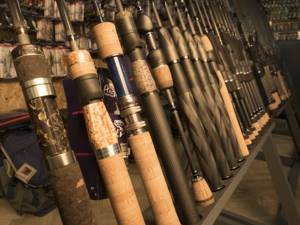
Salmon fishing with spinning rod
In spinning fishing, the selection of the optimal bait is of great importance. This predator needs baits that will provoke the fish to attack the same lure quickly and decisively. To do this, it is important to ensure such a visual effect and vibration that will be as similar as possible to the movements of the usual salmon prey.
It is worth considering that salmon very rarely react to movement that is too fast and passing in the distance, while baits moving slowly near the bottom are very attractive to this predator.
Tackle
In order to catch really big salmon, you need to have a quality fishing rod in your arsenal. Its size should be about 3 meters.
When choosing a fishing rod, you need to take into account that it is designed for bait, the entire weight of which is 40 grams, and at the same time, the weight of the fish that will be caught with this bait should be about 10 kilograms.
Also, when going salmon fishing, you need to take fishing line with you, preferably several skeins. The diameter of the fishing line should be 0.2-0.5 mm. It is not recommended to use braided fishing line for fishing; it is best to choose mono.

You should always remember that red fish itself is very strong. Therefore, you need to have as much fishing line with you as possible, because salmon can make impressive throws. In order to prevent the fish from breaking loose, you need to have at least 150 meters of fishing line.
Before you go fishing, you need to check that all the rings, carabiners and clasps are firmly seated. You need to make sure you have good equipment. It is important to take into account that salmon is a finicky fish and will ignore rough tackle.
Spinner for salmon
Most often, when fishing for salmon, oscillating spoons of large weight and length are used, the performance of which directly depends on the strength of the current, width and depth of the reservoir.
It is generally accepted that a salmon lure should touch the bottom the first time it is cast across the current. The angle of the fishing line in relation to the bottom is approximately 45 degrees.
In such conditions, the wiring will be attractive to the predator, and the chance of snags will decrease.
We have compiled a short list of the most catchy lures for salmon. Much attention was paid to salmon spinners from the Kuusamo company, which showed their high efficiency in catching salmon, pink salmon, taimen, grayling, trout and even pike. Naturally, these spoons can easily catch other types of fish, but time has shown that their calling is salmon fishing .
River salmon fishing. Fishing methods and bait
There are few who do not love excellent salmon, because it has unique flavors and soft meat. However, in order to get this fish on the table, you must first catch the salmon itself, or buy it, which is not so interesting.
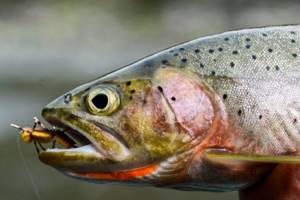
Catching river salmon, this dexterous predator, is done by some with fly fishing, by others with spinning rods, but undoubtedly occupies a huge place in the heart of any angler.
First of all, the method of catching salmon depends on the fishing locations. The shallow rivers of the Kola Peninsula are perfect for inexperienced fishermen, because all you have to do is find a place where the fish stay. Another thing is the waters of Finland and the Leningrad region, where it is very difficult, but so interesting, to fish for river salmon.
Perhaps it is the difficulty of fishing that allows wild salmon populations to be so numerous and not decline, despite environmental problems. Most of the salmon rivers are in Finland, and the country's residents take good care of the rivers, maintaining the population. Finding the key to Finnish salmon is extremely difficult, because even determining the parking spot is almost impossible even for a very experienced fisherman; there is simply no place for a beginner.
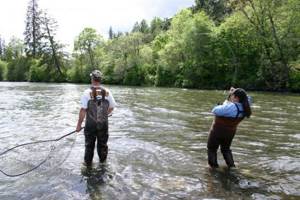
Fishermen are attracted by rapids and riffles, so wide, full-flowing rivers simply confuse them, without giving a single clue. However, if you got a couple of tips from local old-timers, the reward could be a giant weighing more than 15 kilograms. If you don’t have the opportunity to fish in Finland, Russia also has a number of excellent salmon rivers – the Neva, Kumi and others. Usually, there are also many fishermen present for this type of fish.
Methods of catching river salmon
So, in order to catch wild salmon, you must first determine what method of fishing will take place - spinning or fly fishing. The spinning method is considered the most effective, so we will proceed from this constant. The length of the rod for the most effective fishing should be from 2.6 to 3 meters, but this depends on the preferences of the fisherman. Just remember that you won't need to move the rod much, so don't reduce the weight.
The main thing in choosing a fishing rod here is the action. The average one is considered the best. We must remember that salmon fight to the last, so it will take a long time to tire it out. Typically, a salmon bite ends with a powerful jerk and a broken fishing line; this is a common pattern of action. This is where multiplier reels come to the rescue, because they are highly reliable. Do not use braided fishing line; it will not hold up to salmon.
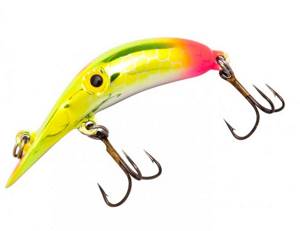
Salmon fishing occurs both from a boat and from the shore, so you should also take care of the landing net. Most salmon caught are released back into the river, so it is vital not to harm the fish too much. Modern cuttings allow you to avoid this. The Finns use the most effective bait in salmon fishing, so it’s worth adopting their experience. They use handmade wobblers. These wobblers are distinguished by a special shape - a blade, usually quite thick, 6 to 8 cm long.
Salmon are always ready to take the bait if you present it correctly, aiming at the bottom, which is strange, because salmon a priori do not feed in the river.
Thank you for fishing with us! Or not yet? Yandex.Zen Facebook
Tags
: how to catch salmon on the river
Posting the spinner
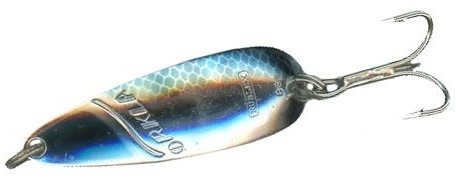
The first cast is made across the river flow. As soon as the bait touches the bottom, you need to sharply lift the end of the spinning rod to lift it a little, and make a series of quick turns of the reel in order to eliminate the slack.
Next, the line is released again, but again without allowing any slack, and a new moment is expected when the bait reaches the bottom. With 3-4 turns of the reel, the bait rises from
The direction of movement of the bait in relation to the direction of the fish's throw determines the nature of the bite.
With a transverse bite, a feeling of a hook or a soft blow may be created, while at other angles there is a push or the line sags, then the reeling stops; The rod is held at an acute angle of 30 degrees to the surface of the water.
Then the current itself will carry the spoon away. The new cast should be made either a little further or a little closer than the previous one.
Salmon fishing (video)
Author of the article: Vitaly Leonidovich Ivanov, 2021.
Where to catch salmon
Salmon is considered a coming fish, which is usually found in the sea or lake. The only purpose of salmon in the river is to reproduce. Most of the fish of this species, after they turn 6 years old, begin to enter fast rivers. They rise to the surface quite infrequently.
It is also quite difficult to track when salmon will appear in the river in the new season, because their arrival is not uniform. Some species of salmon enter rivers in summer and early autumn on the verge of spawning. Other species appear in rivers later in autumn and only then can they be found in early spring. As a parking place, salmon choose a place where there is a rocky or pebble surface.
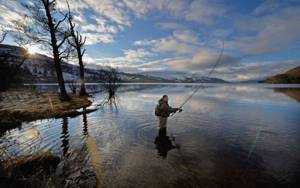
Tackle for Atlantic salmon
When fishing for Atlantic salmon, anglers use powerful spinning rods with a weight of 5 to 21 grams and a length of 2.4 meters to 3.5 meters. These spinning rods are equipped with:
- an inertial or multiplier reel with a spool line capacity of up to 100 meters of fishing line with a cross section of 0.6 mm;
- fishing line and braided cord with a breaking load of up to 15 kg;
- The bait is equipped with a hook size 8.5 - 10 with a triple hook.
A leash is required when fishing for Atlantic salmon. When fishing for salmon on a float, the following are used:
- a fishing rod made of any durable material, equipped with guides, fast action, up to 3.6 meters long;
- inertial or multiplier coil with a low gear ratio;
- fishing line or braid with a high breaking load.
- a float that is clearly visible from a distance;
- triple or single hook;
Knowing the travel time of the fish, it is also necessary to find the best river in terms of fishing, as well as in terms of communication. A short, powerful, deep river is best; The riverbed has a large slope and is littered with large stones. The water should be crystal clear, and not brown, swampy or peaty. Such rivers usually connect mountain lakes with the sea.
In addition to the meteorological reasons known to every angler that influence the bite of any fish, when fishing for salmon, it is necessary to take into account additional reasons that greatly influence the success of fishing. Approaching the mouth of the river, salmon accumulate in groups at the border of salt and fresh water in order to more gradually accustom their bodies to the transition to fresh water. At the slightest rise in water in the river (flood), a whole batch of salmon, already prepared for fresh water, immediately rushes into the river. The fisherman should not miss the flood, as the success can be amazing. I once had 6, and another time 5 salmon on a fishing rod in half a short autumn day of fishing; on ordinary days. It’s good if you take 1-2 salmon, otherwise there are empty days when, at low water, only, apparently, single specimens enter the river. The ebb and flow of the sea is of great importance, especially if you are fishing near the mouth of a river.
It seems to me that only the instinct of salmon can explain the fact that it always waits for the tide, which makes it easier for it to travel up the river, sometimes 1-2 kilometers long.
So! Keep an eye on the rising water in the river, as well as the tide, and you will significantly increase your chances of getting a bite.
The next subject of study for the angler is to carefully familiarize himself with the individual sections of the river where fishing can and should be done. This study is carried out during the fishing itself and is therefore often ignored by the fisherman, who is usually distracted by more entertaining observations.
However, when fishing for salmon, the most detailed study of the reservoir is often decisive, and here’s why. Rising up the river, salmon tries to pass through the rapids of the river without stopping, since it is difficult for it to find at least a slightly comfortable place to rest, and at the slightest stop it will be carried back down by a stormy stream of water. Sometimes at the bends of the river, or at a cape sharply protruding into the river, one half of the river can be foamy and stormy, and along the other bank, sometimes for 100-200 meters, the river has a relatively calm flow.
It is absolutely clear that in these places every salmon that has previously passed 1-2 kilometers of continuous rapids will want to rest. It is clear that it is here, and not on the threshold, that we must catch him. But practice has shown that these rest areas, in turn, have the most convenient parking areas. I have always been amazed that in salmon recreation areas all bites occur only when the spinner or fly passes through two or three very specific places, but there is almost never a bite at a distance of 10-15 meters above, or below, or to the right, or to the left of these points. It is clear that the configuration of the bottom or a well-placed stone provides the salmon with a convenient “harbour” with a smooth, at least quite strong current, quite deep, not close to the shore, and in the vicinity of the main stream of the river, where there are no turbulences of water that are unpleasant for it (flowing around a stone) or streams, sometimes carrying sand with them, irritating the gills of the fish.
Once again, I strongly advise you to remember exactly not the area, but precisely the point where you had a bite, since today, tomorrow and in a year you will again have a bite here. Therefore, the fishing tactics are as follows
: having arrived quietly, carefully and in protective clothing, to a suitable familiar area where “salmon should rest, I pass the spoon 3-4 times (no more, so as not to unnecessarily disperse suitable fish and so as not to waste my tackle) each of the precisely known points. If a salmon is standing here, then it takes it right away, probably almost always from your first cast. If there is no salmon, then sit for 15-20 minutes on the shore, admire the beautiful nature, eat lingonberries and blueberries growing in abundance. If there is another good section of river nearby a little higher or lower, go there and then return to the first one again.
Please note that salmon almost does not approach the banks and therefore the points where bites occur are usually located in the middle of the river and almost always near the border of a stormy and strong stream; Salmon, apparently, does not enter the medium and quiet stream. requirement, important for fishing success, follows directly from this:
, namely: the angler must be able to throw the bait far when necessary and, moreover, always accurately enough. Of course, you can’t throw a spoon just in the place where you expect to get a bite. After several casts, it is easy to come to terms with and adapt to the speed of the river flow in a given place, and then you can quite accurately determine how far upstream, and also how far further you need to throw the spoon so that when reeling in, the spoon carried by the current passes approximately along the target point . Minor inaccuracies can be corrected by increasing or decreasing the speed of winding the line onto the reel.
Questions about how to move the spoon along the surface or closer to the bottom, quickly or slowly, as well as the question about the shape (type) of the spoon, in my opinion, do not matter, since with the transparency and shallowness of mountain rivers with rocky beds, salmon with any depths will notice or feel with the lateral line organs a passing spoon, and in this case he will always rush to a spoon of any shape, as long as it is not dazzlingly polished and does not frighten him with some extremely suspicious appearance or inappropriate vibrations.
It can be directly stated that salmon is one of the most unpretentious fish in this regard and takes on any lure. Personally, I always lead the lure quickly and usually try, if possible, to revive its game by periodically accelerating the reeling, moving the rod, etc. measures.
This is where we will end our consideration of how to act in order to get a bite and assume that during our reasonable behavior on the river bank we felt a sudden, sharp, dead stop of the reel and then two or three short jerks of the fishing line, as a result of which the reel handles flew out of your hand. fingers and spun quickly. This is a powerful, sure salmon bite.
Over the past two years, when fishing, I have been holding the rod not at an angle to the line, but as a direct continuation of the line; the rubber bud of the rod is under the arm, and the reel is near the elbow with the left hand. In this case, a strong salmon bite itself gives a completely automatic hook at the very moment of the bite. And I just hook the rod additionally to set the hooks more firmly. There is nothing to be afraid of if the fishing line breaks, since the bite usually does not happen close to the fisherman and the stretchability of the fishing line provides sufficient shock absorption; with this method you will never be late with hooking. A strong hook is required, since the spoon usually has two tees from 2.1, and sometimes 1.0 numbers, and such large hooks can only be inserted deeply with a solid hook.
For the first half a minute, the salmon just fidgets in place, apparently trying to understand what happened to it and probably trying to spit out the foreign object that got into its mouth, which it so carelessly grabbed. Very soon, convinced of the threatening danger, the salmon begins its first rushes, usually across the river to the opposite bank. These throws can only be imagined by those who have held a salmon on a fishing rod. In terms of speed, these throws can be compared with the first jerks of a sheresper, but in the latter, although they are very swift, they are short, while salmon removes 15-20 meters of fishing line in just one throw without stopping. It is absolutely impossible to stop this throw by using the brake of the reel and, of course, very dangerous, since with full braking the line will inevitably burst. It is much better to set the goal of tiring the fish from the first steps, since you cannot take it by force.
Based on numerous observations made by my comrades and myself, I can give the following basic rules for catching salmon:
:
1) when the fish is in an area convenient for fighting it, try by all means not to frighten it, since in one good throw the salmon can find itself in the most dangerous places;
2) keep the fishing rod under strong tension, but at an angle of no more than 30-40° to the surface of the water and, at the first opportunity, reel in the reel;
3) fight for every decimeter of fishing line, since in a fight with salmon, in a river littered with huge stones, a long line released is more dangerous than in a fight with any other fish;
4) both previous rules do not apply to cases when salmon went against the current. In this case, he tires himself; do not interfere with him in this and lower the line under weak tension;
5) if the salmon, starting to get tired, begins to stop from time to time, sometimes with its nose buried under a stone, and if twitching with the rod does not spook it, then immediately throw stones into the water in the area where the fish stopped until you spook it. It is important for the sink that salmon have a habit, after such a break, to immediately rush downstream, sometimes removing the entire supply of fishing line from the reel;
6) from the very first moments after the bite, you should take a good look at the nearest section of the river and bank in order to notice dangerous, as well as, conversely, advantageous points for fighting;
7) if the fish has gone significantly down and is in a strong current, then sometimes it is not profitable to try to bring the salmon towards you against the current, but, on the contrary, it is more profitable to move along the bank down closer to the fish by reeling in the reel. This is especially beneficial if downstream there are convenient places to continue the fight or bays where you can introduce fish to grab it with your hand or hook;


9) with the first signs of fatigue of the fish, you mark a convenient bay between the stones, where you should introduce the fish in order to grab it with your fingers under the gills, or with a hook;
10) in practice, there were cases when I did not have enough physical strength to turn the reel, even 3-4 turns, if the salmon, having stopped in a strong current, resisted even a little and did not want to go up, closer to me. For me, going down the shore was either impossible, due to the configuration of the shore, or it was unprofitable. In such cases, you need to tightly slow down the reel, retreat along the shore 15-20 steps back and then, running up to the old place, quickly reel in as much fishing line as you can. By repeating this maneuver several times and returning 8-10 meters of fishing line each time, you can finally pull the salmon out of the stormy stream into a relatively calm current, where a normal fight will begin with it. This technique has proven remarkably useful in practice several times.
Concluding the article, I consider it necessary to draw attention to one extremely important circumstance, namely, the equipment of the spinner. The fact is that in practice, unfortunately, salmon go off the hook all too often.
What do Atlantic salmon eat?
The main part of salmon is represented by the migratory form, which is born and spends the first 1-5 years of life in a fresh environment. Here it feeds on zooplankton, larvae, worms, insects, crustaceans, mollusks and fry. If the environment is climatically comfortable and sufficiently nourishing for rapid growth, the fish can leave the river already in the second year of life. In cold conditions and when there is a shortage of food, the maturation of young animals to move to the ocean can take up to 6-8 years. It is this circumstance that is the main reason for the formation of the dwarf form of males, which remain forever in the rivers.
To learn more:
Omul: where the fish are found, what they eat and how they spawn
Having reached a safe size of 20-30 cm, salmon gather in large schools and begin their feeding migration to the sea. Here the fish lead an exclusively predatory lifestyle, hunting sprat, capelin, herring, smelt, and sand lance. The largest accumulation of small ichthyofauna is typical for zooplankton-rich sea waters near Canada and Greenland. This is where the salmon goes to feed, which usually lasts 1-4 years.
Salmon. Let's get to know each other better.
I would like to start with the fact that salmon is a generalized name for fish of the salmon family and specifically, as such, there is no salmon fish. Salmon is a family that includes such types of fish as: trout, sockeye salmon, whitefish, grayling, lenok, malma, pink salmon, salmon, chum salmon, omul and others. The salmon family also includes a currently rare representative - the whitefish. The salmon family is also divided into 3 subfamilies: salmon, grayling and whitefish.
Salmon are either anadromous or freshwater. Migratory salmon live in the Pacific and Atlantic oceans or seas; they enter rivers only to spawn. Freshwater animals are permanent inhabitants of lakes and rivers.
Salmon begin to enter the rivers in early spring and remain there until autumn. Some species of salmon go to spawn only in September–October. During the pre-spawning period, great changes occur in the salmon’s body. The shape of the jaws changes, they become curved - the upper ones down and the lower ones up. The color changes from silver to brighter colors, and degeneration of the intestines, stomach and liver occurs. The meat becomes less elastic and less fatty, which is why it significantly loses value.
Description and characteristics
Despite the fact that salmon and trout are similar in appearance, they differ in the size of their scales, growth rate and dimensions. The maximum size of Atlantic salmon is 1.5 m and weighs more than 40 kg. The same brown trout, or ishkhan, does not grow larger than 15-20 kg even in suitable conditions.
To learn more:
Smelt - features and varieties, beneficial properties and how to cook
External features of the taxon:
- elongated fusiform body;
- a small adipose fin located close to the tail;
- medium, tightly fitting scales (114-130 pieces in the lateral line);
- randomly scattered x-shaped dark pigment spots covering the gill covers and the upper part of the body;
- bluish or greenish color of the back;
- light belly;
- large terminal mouth with strong small teeth;
- silvery flattened sides.
The basic color changes significantly during spawning. The fish becomes darker, the fins turn black, the body acquires a bronze tint, and the spots turn red. Mature males are characterized by a protruding hook on the lower lip, which fits into a special notch on the elongated maxillary bone.
The maximum lifespan of Atlantic salmon is 11-13 years, but usually in nature this figure is much lower - 5-7 years. During this time, he manages to gain weight of 4-10 kg in salt water and go to spawn several times.
